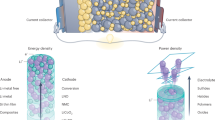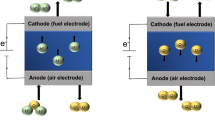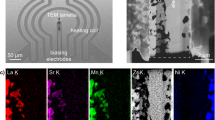Abstract
One promising energy storage technology is the solid oxide electrochemical cell (SOC), which can both store electricity as chemical fuels (electrolysis mode) and convert fuels to electricity (fuel-cell mode). The widespread use of SOCs has been hindered by insufficient long-term stability, in particular at high current densities. Here we demonstrate that severe electrolysis-induced degradation, which was previously believed to be irreversible, can be completely eliminated by reversibly cycling between electrolysis and fuel-cell modes, similar to a rechargeable battery. Performing steam electrolysis continuously at high current density (1 A cm−2), initially at 1.33 V (97% energy efficiency), led to severe microstructure deterioration near the oxygen-electrode/electrolyte interface and a corresponding large increase in ohmic resistance. After 4,000 h of reversible cycling, however, no microstructural damage was observed and the ohmic resistance even slightly improved. The results demonstrate the viability of applying SOCs for renewable electricity storage at previously unattainable reaction rates, and have implications for our fundamental understanding of degradation mechanisms that are usually assumed to be irreversible.
This is a preview of subscription content, access via your institution
Access options
Subscribe to this journal
Receive 12 print issues and online access
$259.00 per year
only $21.58 per issue
Buy this article
- Purchase on Springer Link
- Instant access to full article PDF
Prices may be subject to local taxes which are calculated during checkout




Similar content being viewed by others
References
Dunn, B., Kamath, H. & Tarascon, J-M. Electrical energy storage for the grid: A battery of choices. Science 334, 928–935 (2011).
Isenberg, A. O. Energy conversion via solid oxide electrolyte electrochemical cells at high temperatures. Solid State Ionics 3–4, 431–437 (1981).
Jensen, S. H. & Mogensen, M. 19th World Energy Congr. 5–9 (World Energy Council, 2004).
Jensen, S. H., Larsen, P. H. & Mogensen, M. Hydrogen and synthetic fuel production from renewable energy sources. Int. J. Hydrog. Energy 32, 3253–3257 (2007).
Zhan, Z. et al. Syngas production by coelectrolysis of CO2/H2O: The basis for a renewable energy cycle. Energy Fuels 23, 3089–3096 (2009).
Ebbesen, S. D., Graves, C. & Mogensen, M. Production of synthetic fuels by co-electrolysis of steam and carbon dioxide. Int. J. Green Energy 6, 646–660 (2009).
Graves, C., Ebbesen, S. D. & Mogensen, M. Co-electrolysis of CO2 and H2O in solid oxide cells: Performance and durability. Solid State Ionics 192, 398–403 (2011).
Stoots, C. M., O’Brien, J. E., Herring, J. S. & Hartvigsen, J. J. Syngas production via high-temperature coelectrolysis of steam and carbon dioxide. J. Fuel Cell Sci. Technol. 6, 011014 (2009).
Graves, C., Ebbesen, S. D., Mogensen, M. & Lackner, K. S. Sustainable hydrocarbon fuels by recycling CO2 and H2O with renewable or nuclear energy. Renew. Sust. Energy Rev. 15, 1–23 (2011).
Fu, Q., Mabilat, C., Zahid, M., Brisse, A. & Gautier, L. Syngas production via high-temperature steam/CO2 co-electrolysis: An economic assessment. Energy Environ. Sci. 3, 1382–1397 (2010).
Bierschenk, D. M., Wilson, J. R. & Barnett, S. A. High efficiency electrical energy storage using a methane–oxygen solid oxide cell. Energy Environ. Sci. 4, 944–951 (2011).
Hauch, A., Jensen, S. H., Ramousse, S. & Mogensen, M. Performance and durability of solid oxide electrolysis cells. J. Electrochem. Soc. 153, A1741–A1747 (2006).
Knibbe, R., Traulsen, M. L., Hauch, A., Ebbesen, S. D. & Mogensen, M. Solid oxide electrolysis cells: Degradation at high current densities. J. Electrochem. Soc. 157, B1209–B1217 (2010).
Hjalmarsson, P., Sun, X., Liu, Y-L. & Chen, M. Influence of the oxygen electrode and inter-diffusion barrier on the degradation of solid oxide electrolysis cells. J. Power Sources 223, 349–357 (2013).
Tietz, F., Sebold, D., Brisse, A. & Schefold, J. Degradation phenomena in a solid oxide electrolysis cell after 9000 h of operation. J. Power Sources 223, 129–135 (2013).
Knibbe, R., Hauch, A., Hjelm, J., Ebbesen, S. D. & Mogensen, M. Durability of solid oxide cells. Green 1, 141–169 (2011).
Ebbesen, S. D., Graves, C., Hauch, A., Jensen, S. H. & Mogensen, M. Poisoning of solid oxide electrolysis cells by impurities. J. Electrochem. Soc. 157, B1419–B1429 (2010).
Matus, Y., De Jonghe, L. C., Visco, S. J. & Jacobson, C. P. Solid Oxide Fuel Cells 8th Proc. Int. Symp. (The Electrochemical Society, 2003).
Virkar, A. V., Nachlas, J., Joshi, A. V. & Diamond, J. Internal precipitation of molecular oxygen and electromechanical failure of zirconia solid electrolytes. J. Am. Ceram. Soc. 73, 3382–3390 (1990).
Perfiliev, M. V. Problems of high-temperature electrolysis of water vapour. Int. J. Hydrog. Energy 19, 227–230 (1994).
Jacobsen, T. & Mogensen, M. The course of oxygen partial pressure and electric potentials across an oxide electrolyte cell. ECS Trans. 13, 259–273 (2008).
Virkar, A. V. Mechanism of oxygen electrode delamination in solid oxide electrolyzer cells. Int. J. Hydrog. Energy 35, 9527–9543 (2010).
Keane, M., Mahapatra, M. K., Verma, A. & Singh, P. LSM–YSZ interactions and anode delamination in solid oxide electrolysis cells. Int. J. Hydrog. Energy 37, 16776–16785 (2012).
Brichzin, V., Fleig, J., Habermeier, H-U., Cristiani, G. & Maier, J. The geometry dependence of the polarization resistance of Sr-doped LaMnO3 microelectrodes on yttria-stabilized zirconia. Solid State Ionics 152–153, 499–507 (2002).
Chen, K. & Jiang, S. P. Failure mechanism of (La, Sr)MnO3 oxygen electrodes of solid oxide electrolysis cells. Int. J. Hydrog. Energy 36, 10541–10549 (2011).
Chen, K., Ai, N. & Jiang, S. P. Performance and stability of (La, Sr)MnO3–Y2O3–ZrO2 composite oxygen electrodes under solid oxide electrolysis cell operation conditions. Int. J. Hydrog. Energy 37, 10517–10525 (2012).
Kim, J. et al. Degradation mechanism of electrolyte and air electrode in solid oxide electrolysis cells operating at high polarization. Int. J. Hydrog. Energy 38, 1225–1235 (2013).
Guan, J. et al. High Performance Flexible Reversible Solid Oxide Fuel Cell (GE Global Research Center, 2007).
Mawdsley, J. R., David Carter, J., Jeremy Kropf, A., Yildiz, B. & Maroni, V. A. Post-test evaluation of oxygen electrodes from solid oxide electrolysis stacks. Int. J. Hydrog. Energy 34, 4198–4207 (2009).
Sohal, M. S. et al. Degradation issues in solid oxide cells during high temperature electrolysis. J. Fuel Cell Sci. Technol. 9, 011017 (2012).
Laguna-Bercero, M. A., Campana, R., Larrea, A., Kilner, J. A. & Orera, V. M. Electrolyte degradation in anode supported microtubular yttria stabilized zirconia-based solid oxide steam electrolysis cells at high voltages of operation. J. Power Sources 196, 8942–8947 (2011).
Rashkeev, S. N. & Glazoff, M. V. Atomic-scale mechanisms of oxygen electrode delamination in solid oxide electrolyzer cells. Int. J. Hydrog. Energy 37, 1280–1291 (2012).
Barfod, R. et al. Detailed characterization of anode-supported SOFCs by impedance spectroscopy. J. Electrochem. Soc. 154, B371–B378 (2007).
Gazzarri, J. I. & Kesler, O. Electrochemical AC impedance model of a solid oxide fuel cell and its application to diagnosis of multiple degradation modes. J. Power Sources 167, 100–110 (2007).
Liu, Y. L., Thydén, K., Chen, M. & Hagen, A. Microstructure degradation of LSM–YSZ cathode in SOFCs operated at various conditions. Solid State Ionics 206, 97–103 (2012).
Backhaus-Ricoult, M. et al. In-situ study of operating SOFC LSM/YSZ cathodes under polarization by photoelectron microscopy. Solid State Ionics 179, 891–895 (2008).
Cable, T. L., Setlock, J. A., Farmer, S. C. & Eckel, A. J. Regenerative performance of the NASA symmetrical solid oxide fuel cell design. Int. J. Appl. Ceram. Technol. 8, 1–12 (2011).
Tang, E. et al. Advanced Materials for RSOFC Dual Operation with Low Degradation (Versa Power Systems, 2012).
Njodzefon, J-C., Klotz, D., Menzler, N. H., Weber, A. & Ivers-Tiffée, E. 10th Eur. SOFC Forum 80–91 (European Fuel Cell Forum AG, 2012).
De Jonghe, L. C. Transport number gradients and solid electrolyte degradation. J. Electrochem. Soc. 129, 752–755 (1982).
Acknowledgements
This work was supported by the Program Commission on Sustainable Energy and Environment, The Danish Council for Strategic Research, through the SERC project (http://www.serc.dk), contract no. 2104-06-0011, and the Nordic Energy Research Council (NER) project no. 40000. We thank A. Hauch, M. Davodi and H. Henriksen for help and assistance with the experimental work, and other colleagues at DTU Energy Conversion for support and valuable discussions.
Author information
Authors and Affiliations
Contributions
C.G. conceived the project and executed the electrochemical experiments and scanning electron microscopy analysis. C.G., M.B.M., S.D.E. and S.H.J. designed the electrochemical experiments. S.D.E. improved/developed the experimental set-up. S.B.S. executed the transmission electron microscopy analysis. C.G. wrote the paper with contributions from S.D.E., S.B.S., S.H.J. and M.B.M.
Corresponding author
Ethics declarations
Competing interests
The authors declare no competing financial interests.
Supplementary information
Supplementary Information
Supplementary Information (PDF 1245 kb)
Rights and permissions
About this article
Cite this article
Graves, C., Ebbesen, S., Jensen, S. et al. Eliminating degradation in solid oxide electrochemical cells by reversible operation. Nature Mater 14, 239–244 (2015). https://doi.org/10.1038/nmat4165
Received:
Accepted:
Published:
Issue Date:
DOI: https://doi.org/10.1038/nmat4165
This article is cited by
-
TiO2-induced electronic change in traditional La0.5Sr0.5MnO3−δ cathode allows high performance of proton-conducting solid oxide fuel cells
Science China Materials (2023)
-
Electrochemical behaviors of copper/manganese-doped ceria cermet as a fuel electrode for high-temperature solid oxide cells
Journal of Applied Electrochemistry (2023)
-
Structural and electrical properties of Ba3NbMoO8.5 (BNM) hexagonal perovskite for solid electrolyte application
Applied Physics A (2023)
-
Promoting catalysis activity with optimizable self-generated Co-Fe alloy nanoparticles for efficient CO2 electrolysis performance upgrade
Nano Research (2023)
-
Revitalizing interface in protonic ceramic cells by acid etch
Nature (2022)



